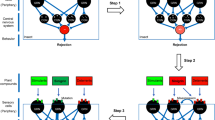Abstract
The galeal chemosensory system of the adult Colorado potato beetle was used as a model to study the effects of alkaloids on insect gustation. Nine alkaloids, representing a wide range of structural types, were used. Their ability to stimulate chemosensory cells when presented in isolation and their ability to interfere with normal chemosensory processes were emphasized. None of the alkaloids stimulated chemosensory cells in a dose-dependent manner, although a few stimulated low-level activity from some cells. There was no evidence for a general “deterrent receptor” in these beetles. Some of the alkaloids had a marked inhibitory effect on normal chemosensory responses. Tomatine, solanine, papaverine, and sparteine significantly inhibited responses to amino acids (represented by GABA) while quinine and papaverine inhibited responses to sucrose. An attempt was made to correlate neurophysiological action of some alkaloids with their effects on feeding behavior. It was clear from this correlation that even a dramatic inhibition of sensory input by an alkaloid does not necessarily lead to measurable effects on behavior. The results are discussed in the context of current theories on the mode of action of alkaloids and other secondary plant compounds which may be involved in host recognition by phytophagous insects.
Similar content being viewed by others
References
Blom, F. 1978. Sensory activity and food intake: a study of input-output relationships in two phytophagous insects.Neth. J. Zool. 28:277–340.
De Boer, G., Dethier, V.G., andSchoonhoven, L.M. 1977. Chemoreceptors in the preoral cavity of the tobacco hornworm,Manduca sexta, and their possible function in feeding behaviour.Entomol. Exp. Appl. 21:287–298.
Davis, E.E. 1985. Insect repellents: Concepts of their mode of action relative to potential sensory mechanisms in mosquitos (Diptera: Culicidae).J. Med. Entomol. 22:237–243.
Derby, C.D., Reilly, P.M., andAtema, J. 1984. Chemosensitivity of lobster,Homarus americanus, to secondary plant compounds: Unused receptor capabilities.J. Chem. Ecol. 10:879–892.
Dethier, V.G. 1980. Evolution of receptor sensitivity to secondary plant substances with special reference to deterrents.Am. Nat. 115:45–66.
Dethier, V.G. 1982. Mechanisms of host-plant recognition.Entomol. Exp. Appl. 31:49–56.
Dethier, V.G., andCrnjar, R.M. 1982. Candidate codes in gustatory system of caterpillars.J. Gen. Physiol. 79:549–569.
Harrison, G.D. 1985. Host plant discrimination and the evolution of feeding preferences in the Colorado potato beetle,Leptinotarsaa decemlineata (Say) MSc thesis. University of Alberta.
Harrison, G.D., andMitchell, B.K. 1988. Host-plant acceptance by geographic populations of the Colorado potato beetleLeptinotarsa decemlineata: The role of solanaceous alkaloids as sensory deterrents.J. Chem. Ecol. In press.
Hodgson, E.S., Lettvin, J.Y., andRoeder, K.D. 1955. Physiology of a primary chemoreceptor unit.Science 122:417–418.
Hsiao, T.H. 1968. Isolation of phagostimulative substances from the host plant of the Colorado potato beetle.Ann. Entomol. Soc. Am. 61:476–484.
Ishikawa, S. 1966. Electrical response and function of a bitter substance receptor associated with the maxillary sensilla of the larva of the silkworm,Bombyx mori L.J. Cell. Physiol. 67:1–12.
Jermy, T. 1961. On the nature of the oligophagy inLeptinotarsa decemlineata (Say) (Coleoptera: Chrysomelidae).Acta Zool. Acad. Sci. Hung. 7:119–132.
Jermy, T. 1966. Feeding inhibitors and food preference in chewing phytophagous insects.Entomol. Exp. Appl. 9:1–12.
Jermy, T. 1983. Multiplicity of Insect antifeedants in plants, pp. 223–236,in D.L. Whitehead and W.S. Bowers (eds.). Natural Products for Innovative Pest Management. Pergamon Press, New York.
Ma, W.C. 1972. Dynamics of feeding responses inPieris brassicae Linn, as a function of Chemosensory input: a behavioural, ultrastructural and electrophysiological study.Med. Landbouwhogeschool Wag. 72-11:1–162.
Mitchell, B.K. 1978. Some aspects of gustation in the larval red turnip beetleEntomoscelis americana, related to feeding and host plant selection.Entomol. Exp. Appl. 24:340–349.
Mitchell, B.K. 1985. Specificity of an amino acid-sensitive cell in the adult Colorado beetle,Leptinotarsa decemlineata.Physiol. Entomol. 10:421–429.
Mitchell, B.K., andHarrison, G.D., 1984. Characterization of galeal chemosensilla in the adult Colorado beetle,Leptinotarsa decemlineata.Physiol. Entomol. 9:49–56.
Mitchell, B.K., andHarrison, G.D. 1985. Effects ofSolanum alkaloids on chemosensilla in the Colorado potato beetle. A mechanism of feeding deterrence?J. Chem. Ecol. 11:73–83.
Mitchell, B.K., andMcIntyre, M.G. 1986. Description of electrophysiological data using a microcomputer.Physiol. Entomol. 11:181–184.
Mitchell, B.K., andSutcliffe, J.F. 1984. Sensory inhibition as a mechanism of feeding deterrence: effects of three alkaloids on leaf beetle feeding.Physiol. Entomol. 9:57–64.
Morita, H. 1959. Initiation of spike potentials in contact chemosensory hairs of insects. III. D.C. stimulation and generator potential of labellar chemoreceptors ofCalliphora.J. Cell. Comp. Physiol. 54:189–204.
Ritter, F.J. 1967. Feeding stimulants for the Colorado beetle.Meded. Rijksfac. Landbouwwet. 32:291–305.
Schoonhoven, L.M. 1972. Plant recognition by lepidopterous larvae.Symp. R. Entomol. Soc. London 6:87–99.
Schoonhoven, L.M. 1982. Biological aspects of antifeedants.Entomol. Exp. Appl. 31:57–69.
Sen, A., andMitchell, B.K. 1987. Ultrastructure of the galeal sensory complex in adults of the Colorado potato beetle,Leptinotarsa decemlineata.Physiol. Entomol. 12:81–90.
Author information
Authors and Affiliations
Rights and permissions
About this article
Cite this article
Mitchell, B.K. Interactions of alkaloids with galeal chemosensory cells of colorado potato beetle. J Chem Ecol 13, 2009–2022 (1987). https://doi.org/10.1007/BF01041728
Issue Date:
DOI: https://doi.org/10.1007/BF01041728




